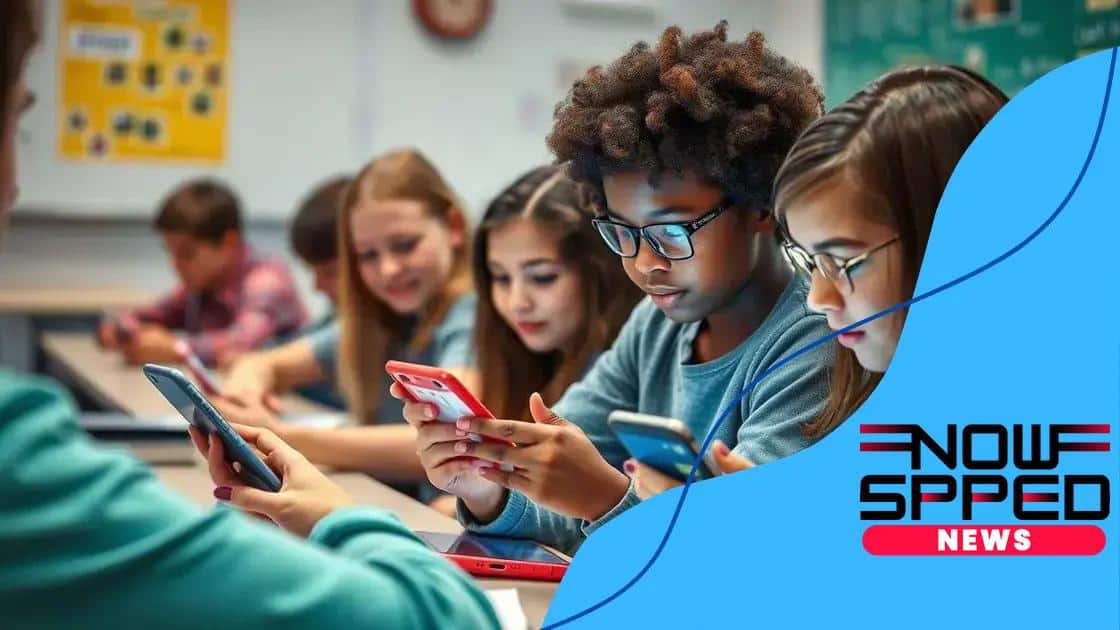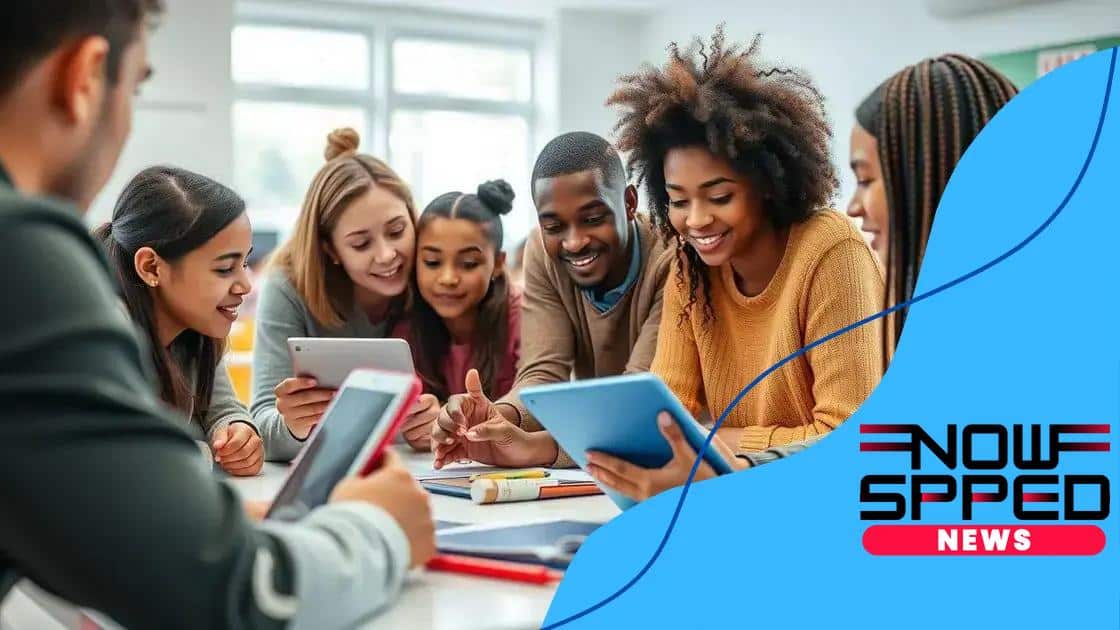Mobile apps enhancing student learning experiences: Unlocking potential

Mobile apps enhancing student learning experiences provide interactive tools, gamification, and personalized content that effectively engage students and improve educational outcomes.
Mobile apps enhancing student learning experiences are changing the way students engage with their studies. Have you noticed how technology is reshaping education? Let’s dive into the benefits of these innovative tools.
Importance of mobile apps in education
Mobile apps play a crucial role in education today. Their importance in enhancing learning can’t be overstated. With these apps, students can access resources and tools anytime and anywhere, making learning more flexible and tailored to their needs.
Benefits of Mobile Apps in Learning
Using mobile apps in education offers several advantages that can transform the traditional learning experience.
- Accessibility: Students can learn on-the-go, accessing materials right from their devices.
- Engagement: Interactive elements of apps keep students motivated and involved in their studies.
- Personalization: Many apps adjust to individual learning styles, providing tailored experiences that suit each student.
- Collaboration: Apps often facilitate group work, allowing students to collaborate and learn from each other.
Moreover, the integration of mobile apps in education encourages students to take charge of their own learning. They can explore different subjects at their own pace. This not only makes learning more enjoyable but also helps in retaining information better.
Real-World Applications
For instance, apps designed for language learning include engaging games and exercises that make practicing fun. Similarly, math apps utilize instant feedback for problem-solving, enhancing the learning process. With the power of technology, education becomes more interactive and impactful.
Through these tools, teachers can also track progress and adjust their teaching strategies based on real-time data. This continuous feedback loop benefits both students and educators, fostering a more effective learning environment.
Examples of effective student learning apps
There are many mobile apps designed specifically to enhance student learning. These effective student learning apps provide tools that not only engage students but also support various learning needs.
Popular Learning Apps
Some well-known apps have made a significant impact on education. Here are a few that stand out:
- Khan Academy: Offers a wide range of free courses and practice exercises.
- Duolingo: Makes learning new languages fun with games and interactive lessons.
- Quizlet: Provides flashcards and study games that help with memorization and understanding.
- Google Classroom: A collaborative platform that facilitates communication between teachers and students.
Each of these apps caters to different subjects and learning styles. For instance, Khan Academy is great for math and science, while Duolingo shines in language acquisition.
Benefits of Using These Apps
Using apps like these can greatly benefit students. They promote self-paced learning, allowing students to study when it suits them best. Additionally, many apps offer immediate feedback, which helps students understand their mistakes instantly. This feature is crucial for effective learning.
Moreover, these apps often include gamification elements, making learning enjoyable and rewarding. By earning points or badges, students feel motivated to progress further in their studies.
Beyond individual use, these apps foster a collaborative environment where students can work together on projects or study sessions. This teamwork can enhance understanding and retention of the material.
How apps facilitate collaborative learning

Mobile apps are revolutionizing how students work together. They create spaces where collaborative learning can thrive. By using these apps, students can share ideas, resources, and feedback easily.
Tools for Collaboration
Several apps focus specifically on fostering teamwork among students. Here are some popular options:
- Slack: This app offers channels where students can communicate about different projects.
- Trello: A visual project management tool that helps groups organize tasks and track progress.
- Microsoft Teams: Combines chat, video, and file sharing, making collaboration seamless.
- Google Docs: Allows multiple users to edit documents at the same time, perfect for group assignments.
These tools make it easy for students to connect, no matter where they are. For example, if a group is working on a project, they can discuss ideas in a dedicated chat room while sharing relevant documents.
Benefits of Collaborative Learning Apps
Using apps for collaboration has many benefits. They help students develop important skills, like communication and problem-solving. When students work together, they learn to listen to different viewpoints, which enhances their understanding of the material.
Additionally, these apps promote engagement, as students are more likely to participate when working together. They can brainstorm ideas and provide support to each other, which boosts confidence and makes learning enjoyable. The interactive nature of these platforms encourages active involvement rather than passive listening.
Collaborative learning through apps also prepares students for the future workplace, where teamwork is essential. By practicing these skills in school, they become better equipped to face real-world challenges.
The role of gamification in learning apps
Gamification plays an important role in learning apps. By incorporating game-like elements, these apps make education more engaging and enjoyable.
What is Gamification?
Gamification involves adding game elements to non-game contexts. In education, it means using points, badges, and challenges to motivate students. This approach helps keep learners interested and encourages them to interact with the material.
- Points: Students earn points for completing tasks or answering questions correctly.
- Badges: Digital badges reward achievements, giving students a sense of accomplishment.
- Leaderboards: Showing rankings can inspire friendly competition among peers.
- Challenges: Time-based or skill-based challenges keep students engaged.
When students see their progress tracked through scores or badges, they feel a sense of achievement. This motivates them to continue learning. It also encourages persistence, as they want to earn more points or unlock new levels.
Benefits of Gamification in Learning
Games naturally draw people in. This is why gamification is so effective in learning apps. Students tend to spend more time engaging with the content. They also retain information better when it’s presented in a fun and interactive way.
Moreover, gamified experiences support different learning styles. Visual learners may benefit from interactive graphics, while competitive learners thrive in environments where they can observe their progress against others. This flexibility makes learning more inclusive.
Additionally, gamification fosters critical skills such as problem-solving and teamwork. Students often work together to complete challenges, which enhances their collaboration skills. By making learning feel like a game, students are less likely to see it as a chore and more as an enjoyable experience.
Evaluating the effectiveness of educational apps
Evaluating the effectiveness of educational apps is essential for ensuring that they enhance student learning. Schools and educators need to understand how well these tools work in practice.
Criteria for Evaluation
To evaluate an app’s effectiveness, several criteria can be used:
- User Engagement: Assess how often students use the app and if they find it enjoyable.
- Learning Outcomes: Measure if students improve their understanding of the material.
- Feedback Mechanisms: Look for features that provide instant feedback on students’ performance.
- Accessibility: Ensure the app is accessible to all students, including those with disabilities.
Each of these criteria plays a critical role. By examining user engagement, teachers can determine if the app keeps students interested. Learning outcomes indicate if the app helps students retain knowledge. Feedback mechanisms help students correct their mistakes, making learning more effective.
Methods for Evaluation
There are various methods to evaluate an educational app. Surveys and interviews can provide valuable insights about user experience. Additionally, educators can analyze data from the app to see how well students perform.
Another method is conducting controlled studies where students use the app alongside traditional methods. Comparing results can show the app’s impact on learning. This approach also helps to identify specific strengths and weaknesses.
Collaboration between developers and educators is vital during the evaluation process. Developers can improve their apps based on feedback from teachers and students, making them more effective learning tools.
FAQ – Frequently Asked Questions about Educational Apps
How can educational apps enhance student learning?
Educational apps enhance learning by providing interactive content, instant feedback, and personalized learning experiences, making studies more engaging.
What features should I look for in an educational app?
Look for features like user engagement metrics, learning outcome assessments, feedback mechanisms, and accessibility options for all students.
How can gamification improve the learning experience?
Gamification makes learning fun by using game elements like points, badges, and challenges, which motivate students to participate actively.
Why is it important to evaluate educational apps?
Evaluating educational apps ensures they effectively support learning and meet students’ needs, guiding educators in their choices for teaching tools.





